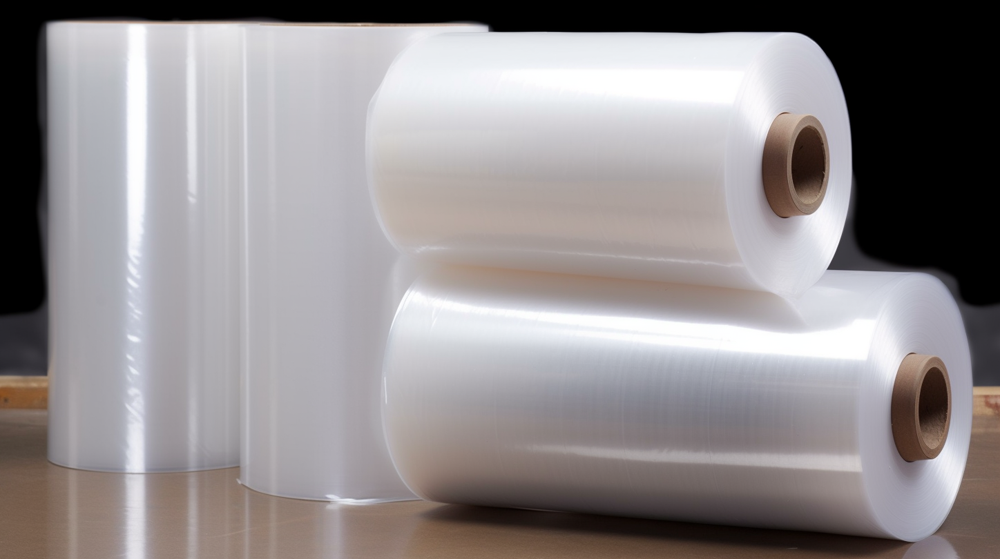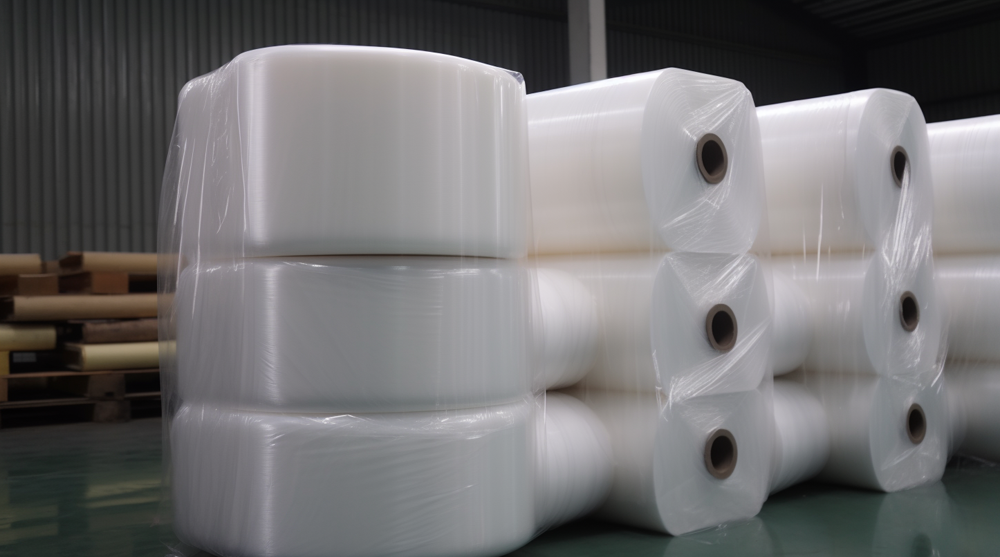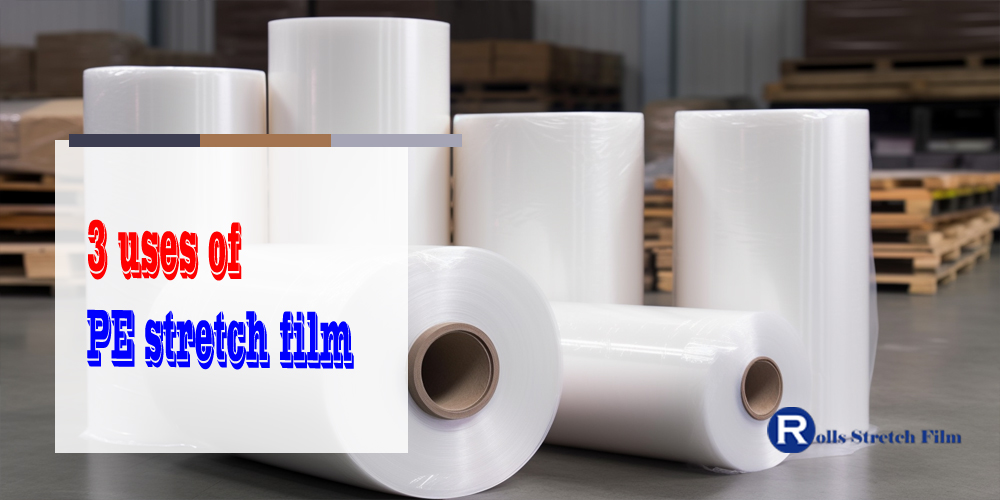Discover how PE stretch film revolutionizes multiple commercial, industrial, and agricultural industries. This magical tool can easily protect your products and save you money in the long run. Are you curious about the three unique ways to use PE stretch film? Let’s dive in and learn more!
Industrial Uses
Commercial Uses
Agricultural Uses
In this article, we’ll explore the different applications of PE stretch film in detail. You’ll learn how this packaging material can benefit your business and improve your supply chain management.
What is PE stretch film?

PE stretch or polyethylene stretch film is a highly elastic plastic film used to protect, secure, and group items together. It has excellent tear resistance and clinginess, allowing it to be wrapped around multiple items and stick to itself easily. PE stretch film is widely used in various industries, including shipping, warehousing, retailing, and more.
The material of PE stretch film is made from stretched linear low-density polyethylene (LLDPE). This type of plastic offers high tensile strength and elongation properties, allowing the film to be stretched up to 300%. The material is resistant to moisture and most corrosive liquids, making it an ideal choice for outdoor use. It also offers great clarity so the contents inside can be easily identified. Furthermore, the material’s durability allows re-use without sacrificing performance or tensile strength.
Regarding applications, PE stretch films are mostly used for bundling materials such as boxes or pallets for shipment purposes. Additionally, they can be used to wrap furniture or other large objects to protect them from dust or dirt during short-term storage. One of the main advantages of using this kind of film is its great capacity for tight wrapping, which keeps products safe and secure during transport. In addition, these types of films are often used in construction projects due to their exceptional strength, making them suitable for insulating buildings against extreme temperatures or weather conditions.
| Type of PE Stretch Film | Size | Common Applications |
|---|---|---|
| Hand Stretch Film | 12-20 inches | Manual wrapping of small to medium-sized products |
| Machine Stretch Film | 20-60 inches | Automated wrapping of pallets and larger products |
| Extended Core Stretch Film | 12-20 inches | Manual wrapping of products without need for dispenser |
| Bundling Stretch Film | 2-5 inches | Securing and bundling small items together |
| UVI Stretch Film | Varies | Outdoor storage or transportation where sunlight exposure is a concern |
| VCI Stretch Film | Varies | Protection of metal products from corrosion |
| Color Tinted Stretch Film | Varies | Identification or differentiation of products |
| Netting Stretch Film | Varies | Wrapping of irregularly-shaped or loose items |
| Anti-Static Stretch Film | Varies | Protection of electronic or static-sensitive products |
| Pre-Stretch Film | 20-60 inches | Reduction of material waste and cost |
3 uses of PE stretch film
Industrial Uses
A. Protection and bundling of products during transportation:
PE stretch film is extensively used in industrial settings for product protection and bundling during transportation. This type of film offers excellent protection against damage caused by moisture, dust, and other external factors that can harm packaged goods. The stretch film’s strong, elastic nature enables it to tightly wrap around delicate equipment or products, keeping them from shifting or rubbing against one another during transportation. Additionally, this film’s high-stretch capabilities allow it to conform to the contours of an item, providing a secure grip that reduces the likelihood of items falling or shifting during shipments. This added protection of products reduces the risk of damage, ensuring that the goods reach their intended destination safely and securely.
B. Securing goods on pallets for storage and handling:
PE stretch film is also indispensable for industrial operations when securing products on pallets for storage and handling. When products are placed on pallets, they must be secured to prevent damage from tipping or shifting during storage and transportation. PE stretch film is ideal for this problem as it can wrap tightly around even the most irregularly shaped products. Due to the film’s elasticity, it can be stretched to its fullest extent before it is wrapped tightly around the object, providing added security while maintaining a firm grip. Once secured, the pallets can be safely handled by warehouse workers and shipped across long distances.
C. Sealing and wrapping of goods in warehouses and distribution centers:
PE stretch film is instrumental in sealing and wrapping goods in warehouses and distribution centers. This type of film creates a tight barrier around an object, protecting it from dust, dirt, and other environmental factors. This added protection ensures that products remain in pristine condition while they are being stored or handled. Additionally, this film is easy to apply and remove, reducing the time needed to wrap or unwrap goods. Moreover, the film provides a secure seal and ensures that the products are kept confidential in transit, mainly when shipped to different locations. Using this type of film improves the overall efficiency of warehouse and distribution center operations and protects the products being stored or shipped.

Commercial Uses
A. Wrapping food items to prolong freshness:
PE stretch film is commonly used in the food industry to wrap items such as meat, fruits, and vegetables to keep them fresh for longer periods. The film helps to prevent moisture loss and exposure to air, which can cause spoilage and oxidation. It creates a protective barrier that can extend the shelf life of food items, reducing food waste and increasing profitability. The film is also transparent, allowing customers to see the contents of the package easily. Additionally, the material is non-toxic and food-grade, ensuring it does not contaminate the food.
B. Covering furniture and other items during transportation or storage:
PE stretch film is an effective way to protect furniture and other items during transportation or storage. The film can be wrapped tightly around the item, creating a secure barrier that prevents dust, dirt, and moisture from entering. This helps maintain the item’s condition, reducing the likelihood of damage and increasing its lifespan. The film is also easy to apply and remove, making it a convenient solution for protecting many items.
C. Protecting documents and other important items from water/moisture damage:
PE stretch film can protect documents and other important items from water and moisture damage. The film can be wrapped tightly around the item, creating a waterproof barrier that prevents water from entering. This helps safeguard important files, documents, or other items, keeping them safe and secure. The film is also resistant to tears and punctures, ensuring that the item remains well-protected even during transportation or storage. PE stretch film is a versatile and cost-effective solution for protecting many items.
Agricultural Uses
Wrapping hay bales with PE stretch film is a common agricultural practice to protect them from harsh weather conditions and pests.
It creates a barrier that shields bales from moisture, which can ruin their quality and nutritional value. Additionally, with proper sealing, the stretch film prevents molds and fungi from growing on the hay, which can also affect its quality. Regarding pest protection, the film can deter rodents, birds, and insects that may otherwise cause significant damage to stored hay. PE stretch film is ideal for hay bale wrapping as it has high puncture resistance and durability, ensuring bales are protected for extended storage periods.
Enclosing greenhouses with PE stretch film is a practical way to regulate temperature and humidity levels inside the structure.
The film provides excellent insulation and reduces heat loss, making maintaining optimal crop growth conditions easier. Additionally, it prevents excessive water evaporation, which helps maintain a consistent humidity level, which is critical for many plants’ growth. With its ability to block harmful UV rays, the film also helps reduce the risk of sun damage to plants, particularly sensitive seedlings. Another benefit of using PE stretch film is that it is lightweight and easy to handle, making installation and maintenance a breeze.
Covering crops with PE stretch film is an effective method of preventing damage from weather and insects.
With climate change impacting weather patterns, the risk of sudden temperature drops, hail, and heavy rain is higher than ever, which can destroy crops. The stretch film creates a protective layer over plants, shielding them from rain, dust, and other contaminants. Additionally, the film’s high UV resistance helps reduce the risk of sunscald and other forms of sun damage to delicate leaves and stems. PE stretch film also helps prevent insect infestations on crops, particularly those susceptible to pests. The film’s tight seal creates an environment that discourages insects from feeding and laying eggs, further protecting crops from damage.
Environmental Impact of PE stretch film
A. Discussion of the environmental impact of PE stretch film:
Polyethylene (PE) stretch film is commonly used in the packaging and transportation of goods due to its excellent stretchability, clarity, and ability to protect items from damage during transit. However, the production and disposal of PE stretch film significantly impact the environment. PE is made from petroleum, a non-renewable resource, and the manufacturing process generates greenhouse gases, such as carbon dioxide and methane, which contribute to climate change. Furthermore, the disposal of PE stretch film, particularly if not properly disposed of, can harm wildlife and marine life, contaminate water, and contribute to the depletion of natural resources.
B. Potential solutions to reduce waste and promote sustainability:
One potential solution to reduce waste and promote sustainability is switching to a biodegradable stretch film made from plant-based materials, such as cornstarch or sugarcane, that have a lower environmental impact than petroleum-based plastics. Another solution is to implement a closed-loop system where used PE stretch film is collected and recycled into new products, reducing the need for virgin materials and decreasing waste. Additionally, reducing the thickness of the film and implementing proper disposal methods, such as recycling or landfill, can also help reduce the environmental impact. Companies can also adopt sustainable packaging practices, such as using reusable containers and minimizing packaging waste, to reduce their environmental impact. Both manufacturers and consumers need to recognize the impact of PE stretch film on the environment and take steps toward reducing waste and promoting sustainability.
| Environmental Impact | Description |
|---|---|
| Non-biodegradable | PE stretch film is made from plastic materials that do not biodegrade and can persist in the environment for hundreds of years. |
| Landfill waste | When not properly recycled, PE stretch film can end up in landfills, taking up valuable space and contributing to waste accumulation. |
| Marine pollution | Improper disposal of PE stretch film can also result in marine pollution, as the film can enter waterways and harm marine wildlife. |
| Greenhouse gas emissions | The production and disposal of PE stretch film can contribute to greenhouse gas emissions, which can contribute to climate change. |
| Resource depletion | The production of PE stretch film requires the use of non-renewable resources such as oil and gas, contributing to resource depletion. |
Taking steps to reduce, reuse, and recycle PE stretch film can help mitigate some of these impacts.

PE stretch film is a versatile and cost-effective solution that significantly improves your business operations. Using this packaging material can reduce waste, protect your products, and save money.














